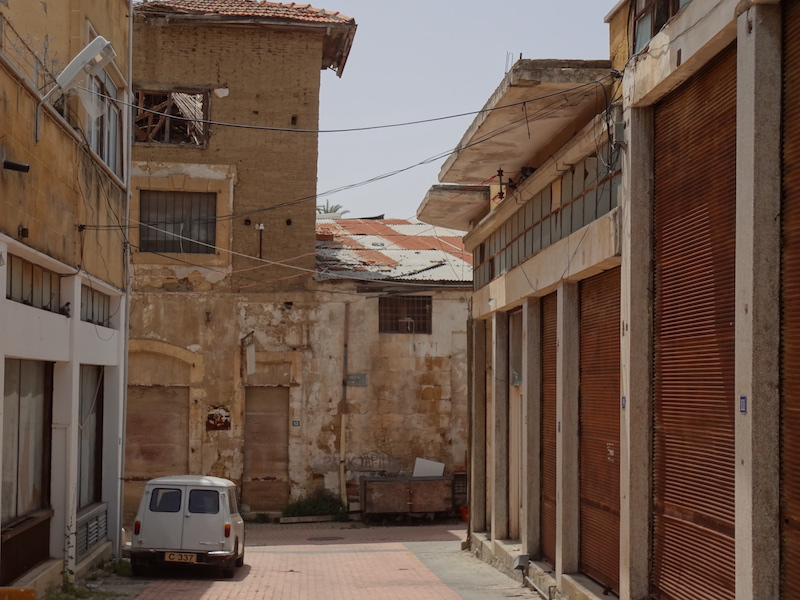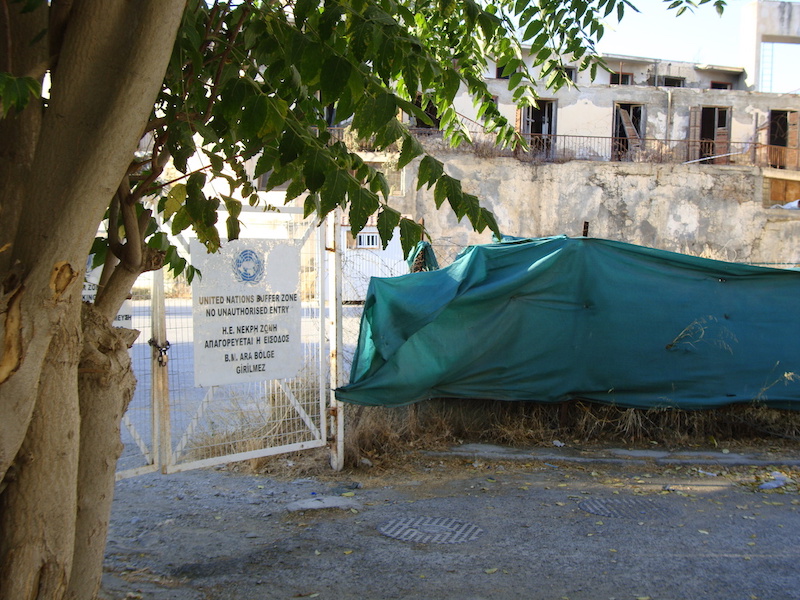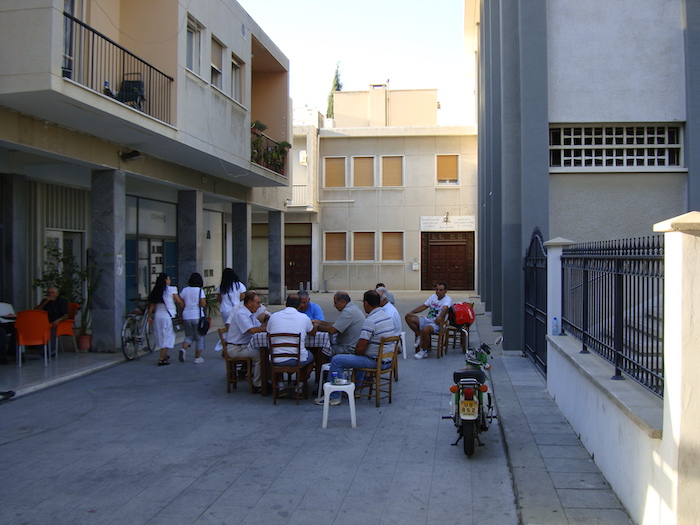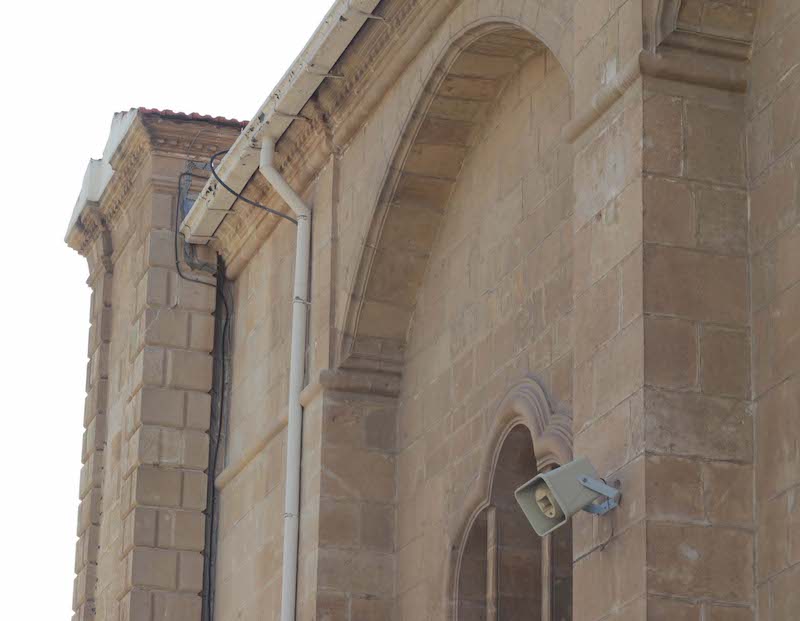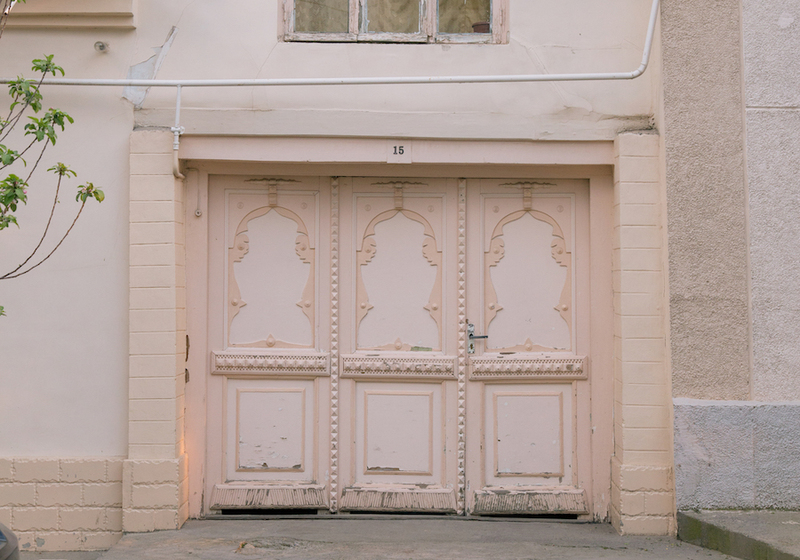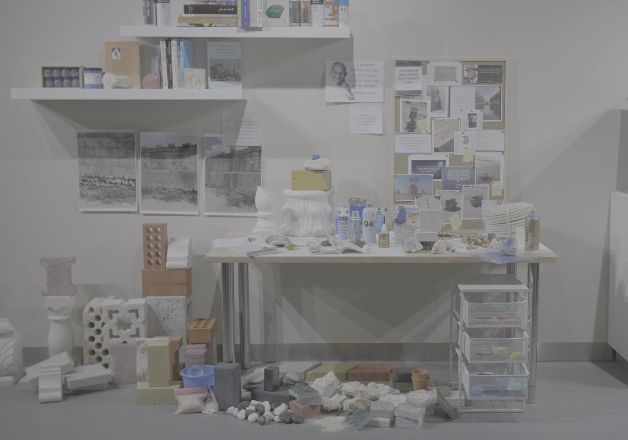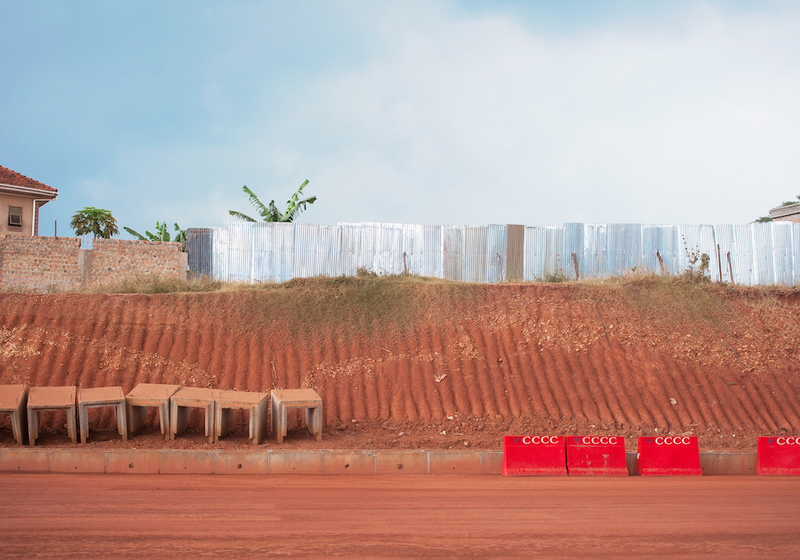CC BY-SA
For almost half a century, the island of Cyprus has been divided into two parts where different ethnic and religious communities live, both autonomously and in close everyday connection with one another. Anthropologist Yiannis Christidis, one of the winners from our (no)borders open call, talks about his exploration of the island’s uniform acoustic environment and sounds that defy human-made barriers.
The hive origins
The island of Cyprus is situated at the eastern edge of the Mediterranean. It is a sunny, multi-cultural country, mostly inhabited by Greek-Cypriots and Turkish-Cypriots, along with Turkish settlers, migrants, refugees, and other minorities. This divided island has a total surface of 9520 sq. km and is populated by 800,000 people. The southern part of the island consists of the areas controlled by the Republic of Cyprus, the only de jure state on the island, while the northern part is occupied, run under a Turkish-Cypriot administrationadministrationTurkey is the only country that recognizes the de facto state as “Turkish Republic of Northern Cyprus.”. This status was finalized in 1974, after a Turkish invasion of the north of Cyprus made in response to a military coup on the island orchestrated by the Junta of Athens, in Greece. As a result of the invasion, apart from an estimated 6,000 to 9,500 casualties, around 250,000 residents from both sides were forced to leave their properties and become refugees in their land, to the respective parts of the island. Consequently and to this day, it is mostly Turkish Cypriots and Turkish settlers who live in the northern part of the island, while Greek Cypriots inhabit the southern part. The conflict, which reached its peak in 1974, appears now generally subdued, as community leaders have been seeking a political solution.
On the island, Greek Cypriots and Turkish Cypriots often cooperate for various common purposes: some work together on an everyday basis, others collaborate for assorted projects (peace-building themes included), while in certain bordered neighboring residential areas like Nicosia, their everyday encounters are common. In general, the rhythms of life where both communities are geographically close, include all members showcasing a sociocultural proximity. It is only far-right extremists and radical conservatives on both sides who are the ones to politically invest in a culture of conflict, which is mostly enacted on either a political or a religious level.
Since 1974, the city center of Nicosia is divided by a “wall,” which is not, however, made up of a concrete, physical structure. Instead, this “iron curtain”—which was initially constructed in 1958 by Turkish Cypriots and materially reinforced in 1963—is a combination of various roadblocks along the city center that consist of barriers of different types, placed in order to set the boundaries dividing the city, as well as the ethnic communities inhabiting it. Geographically, the South is separated from the North with an empty zone, sometimes known as “No-Man’s land,” “Green Line,”“Green Line,”“The Green Line, whose name originated in Nicosia during communal violence in 1958 when a British administrator drew a line on a map of the city with a green crayon to identify the ‘front line,’ became an iron curtain of 220 kilometers running horizontally across Cyprus” (Contested Lands: Israel-Palestine, Kashmir, Bosnia, Cyprus and Sri Lanka, 2007, p. 88) or “Buffer Zone.” This borderland, controlled by the UN, aggressively constitutes the significant (non)place of the above conflict—both an actual and symbolic sensitive vein on the body of the island.
CC BY-SA
My ethnographic research takes place at the old walled city center of the capital of Cyprus, which is the area that the Green Line of separation passes through, dividing the city (and the entire island). The area of study is the oldest part of Nicosia, rich in historical, cultural, and social heritage. There, the borderland brands the visual experience, and inevitably the overall way of life of the residents. At both sides, sparse dead ends, street barriers, and small army posts establish a landscape that prevents people from having a common urban experience, stops them from walking freely in any direction, and prevents them from even looking where they want. The only way to cross to the other side of the very same neighborhood is through the formal police checkpoint, situated at the very center of the city. To me, wearing the shoes of an observer with ethnographic concerns, the old city of Nicosia resembles a bordered hive: one obstructed multicultural place full of the communities’ actions and dynamics, forcefully separated by visual barricades. Such a context can only elevate the significance of the sound resonating from the other side.
The Soundscape and the way Others sound
In an attempt to better understand the divided city center’s dynamics, I deliberately focus on the resonances of the place. By either acquiring the role of a social researcher, an observing artist, or just a flâneur, a walker can understand the characteristics of a place by carefully listening to it. Within this context, I try to (both metaphorically and actually) map the acoustic image of the city: its sound details, the everyday soundscapes, how the north sounds, how the south sounds, and how the dividing Buffer Zone sounds. To do this, I am soundwalkingsoundwalkingSoundwalking is a practice introduced by Hildegard Westerkamp in the 1970s, during which a small group of people walks around a place with the sole purpose of experiencing it through listening to it. It is common practice that the group remains silent and attentive during the session, while it ends up with a fruitful discussion among the group members regarding their experience during the walk. in the area. This practice reveals hidden aspects of a place to the practitioner, utilizing the perspective of the aural experience. My own views are depicted in the following lines, which self-reflect my experience during a walk in the place under discussion, both in the South and North. The sound variety which is composed by micro sounds, assorted spatial qualities, natural and human sounds, and of course the resonances of the soundmarkssoundmarksThe soundmarks of a place are traditionally defined as sounds which are significant for a community, specially regarded by its members, and hence of cultural importance. Such sounds can be a horn of the departing boat for the community living in a harbor or the sound of the Big Ben for the Londoners.
, form an acoustic image of the place.
Beginning of the recording
Starting from the area of Paphos Gate, where the old, calm area of the city center meets the new buildings and the big and noisy streets, I sense the quietness that lies beyond this point. It is not the buildings, but the sounds that appear to be masked when passing the starting point of the soundwalk. And this is what actually happens: entering the old city center of Nicosia, car sounds cut out and become a far lo-fi soundscape, when new, more detailed and accurate sounds come to the foreground. The school ambience and action coming from the coffee shop where elderly people spend their time, mark what a soundwalker hears. Two of them are playing backgammon; the sound of dice rolling and their checkers hitting the wooden board stand out in the relatively silent ambience. Murmuring, newspaper page turning, and sounds coming from the kitchen of the coffee shop are also present, while walking outside of the Holy Cross Catholic Church. Walking through the narrow streets, alert by the quiet talking of the army guards in front of their military checkpoint, and noticing the sound of leaves rustling and birds chirping, mixing with the lo-fi occasional presence of a working air conditioner box outside some buildings, I reach an alley where sound is circulated, leaving my ears exposed to the reverberations created by the high walls.
CC BY-SA
The open-air parking areas that I have to cross in order to reach the crossing point, create another quality, that of an abandoned area, as they are quiet, with a terrain texture that is not taken care of, full of dust and small rocks. Standing for a while in the south crossing point of Ledra street, I can focus more on the sound of people passing by, talking on their phones, talking to each other, shouting at their kids. Cell phones, music from the nearby tourist shops, and people entering and leaving shops and cafes compose the soundscape of this point.
When crossing the Buffer Zone, the entire ambience changes all of a sudden. While walking through large white iron doors hiding the abandoned and ruined houses of the area, the sound also seems to be missing something. The seventy steps one needs to cross the “Dead Zone” are enough to make them feel the emptiness of the sound environment, leaving the sound of the city behind, and moving towards a sound of another city, yet the same one. At the Turkish checkpoint, where few people are patiently queuing, waiting for their access to be authorized and cross the Line, what stands out sonically is the sparse sound of the stamp of the officers on the passports, and the relatively noiseless conversation of the police guards and some tourists.
Having crossed the borders, and still walking across Ledra street, the soundscape slightly changes. After a silent area lies the extension of the deserted Buffer Zone, where tourists and locals appear to give life to the neighboring cafes and shops. Another, less cosmopolitan, yet busy ambience is present, until I leave behind the last CD shop playing music through loudspeakers and head West. The soundscape dries out, becomes calm and silent/soundless; its quality changes. The streets are narrow, they are the same as the ones in the South, but are they dustier? Do they sound more humane? By walking and listening in this specific area, one might think that they are in a village. Every three or four old buildings, houses, or stores, there is an open car repair garage, with few people inside, working or socializing. A printing house establishes a place with the constant noisy sound of its working machines. Walking back, leaving the quiet Turunçlu Fethiye Camii Mosque behind me and heading east, moving through the narrow streets, I enter a tourist area once more, full of shops with clothes hanging on both sides of the street. As a result, this forms an area where the sound of the walkers dries out and gets absorbed by the colorful fabrics, creating a strange, quiet, yet very busy sound environment.
Leaving behind this vivid place, I reach Selimiye Mosque; its wide yard, also hosting some trees, lets the sound circulate in the area, and gives a sense of openness to the ambience. Some meters away, children are playing in the square: they are always there and the sound created by their shouts, games, and running is a constant event. At some point, distant church bells are heard from a church on the other part of the city. I end up, once again, in a rather quiet area, despite the few cars, close to the end of the city walls of North Nicosia, and I am heading back to the crossing point, this time passing from the closed market. The ambience in there is different, it is a calm, closed space, where customers and workers move around and trade vegetables or other products, and the sound reaches the top of the building and then returns back. Following the way back to the border, tourists are still there, shops declare their presence sonically, and the sound of life there reminds of commerce.
Crossing the border for the second time, the sound of the stamp initiates my peaceful short walk along the Buffer Zone, until I reach again the tourist zone, and then end up close to Phaneromeni Church, an open space full of cafes accompanied by the typical sounds of people: chatting, arguing, playing backgammon, or silently reading. Leaving this area and walking across the line, the streets become more narrow, there are fewer cars left, and I am led to a calmer neighborhood, where birds declare their presence and the neighborhood seems to take over the character of the city center. Taht-el-Kale Mosque is the last religious-related sound source before I reach the church of Saint Kassianos and finish the soundwalk in a calm sound environment which, once again, brings a village soundscape to my mind. The silence is interrupted by the call to prayer, which resonates for a few minutes, from the north part of the city, which I have just visited, to the whole city center’s soundscape.
End of the recording

Image by Yiannis Christidis, CC BY-SA
A combination of the elements compiling an (acoustic) image of the place as a whole is now revealed. The experience feels self-matching: The sounds and an understanding of the south would not have been complete without the ones of the north and vice versa: similar, yet different qualities characterize both areas along the Buffer Zone.
An important question arises at this point: is the conflict signified by the sounds travelling over the borders?
ONE CONCEPTUAL SOUNDMARK
In order to attempt a correlation of the aural experience to the conflict under discussion, I place a particular focus on the place’s soundmarks. These are generally observed in the cases where religion forms a strong asset of the community: the Christian community gathers around the church bell, while Muslims’ cycle of prayers depends on the hodja’s call to prayer, heard from the mosque’s minaret, five times per day. When sounding, resonances not only dominate the sound environment, but they also affect the non-religious listeners, sound wise. But in what ways does this happen? And can they be applied to the case of Nicosia? The place also shows another particularity: although there is a number of cities, like Beirut or Cairo, where someone can simultaneously hear the call to prayer and the church bells, the two soundmarks of Nicosia are geographically divided, but also placed together: the resonant mosques are situated to the north, while the churches are to the south.
Naturally, their sound won’t be blocked by the borders, so one can listen to any of the resonating religions, wherever they are. Even if the Green Zone is human-less and silent, it is the constant crossing above the border that sonically happens, representing a peculiar cultural disrespect for the borders. Such a fact though creates space for a wider discussion about a potential conceptual soundmark of a unique acoustic community, negotiating its values and assets in a more ample context: political, religious, cultural, and every day.
Photography by Yiannis Christidis, CC BY-SA
Having implemented the soundwalk, I talked with residents and workers from the area. The discussions were about their neighborhood, their everyday life, their routine, and what they hear during the day. Apart from the noted everyday sounds, most people assured me about the audibility of the soundmarks. Also, most people expressed their disapproval of their high noise level. To my surprise, and regardless of their religiousness, the call to prayer and the sound of the bells do not remind them of the “other” (community), their (or the other’s) God, their duty to pray, the invasion, or the conflict itself. Rather, inhabitants and workers exposed to these sounds assure me of their function as an everyday regulator: one uses the early morning hodja’s call to prayer as an alarm clock to go to work, while another claims to perceive it as a reminder to get the children from school. Accordingly, the Sunday morning’s bells are a place reminder of the Sunday-feeling, rather than a religious communication with God. And although loud, most inhabitants agree that both soundmarks are equally important to the place’s identity, specially regarded, and would be unhappy if for some reason they stopped.
It is the above approach that allows me to safely support that the two ethnic communities appear to form a unique acoustic community, constantly exposed to one conceptual sound which is triggered by both the religious soundmarks, the role of which is enhanced by everyday common sounds. A conceptual soundmark, consisting of not only the religious sounds but also other micro sounds of the place’s everyday life rhythms, proudly resonates a mockery towards the man-made borders, towards discrimination, and conflict expressed by human constructions. The paradox of the rhythms of life due to the sound of the bordered area is raised here, as the above results contribute to its nature.
Here, we can also observe that landscape barriers do not seem to be able to restrict the transgressive property of open-air sound. The emblematic meaning of the two communities’ (loud) soundmarks sets the ground for extended discussions, experimentations, and reappreciation regarding the whole city center, as they enhance people’s attachment to the place. Ironically, resonating mosques (in the north) and churches (in the south), through their respective call to prayer or other rituals’ sound, ignore human made barriers, travel above and across the borders, regulating autonomously the everyday soundscape for both communities. Other, less loud sounds also travel from one side to the other, either above or through the checkpoint, which seems to form the only spot where human (sound) activity is observed. Consequently, inhabitants form constant listeners of a sonic borderless environment, highly related to their everyday activities and sense of place, rather than their religious duties or connotations.
Within the context of the above combined ethnographical process, a sound composition evolved that uses soundmarks and other sounds of the area in an experimental way. The composition intends to negotiate the profile of a nationless acoustic community identity, formed by the resonances of its own members. Such a conceptual sound unconsciously mocks borders, restrictions, and formal religious and political connotations and policies.

